Deck 14: Carbohydrates: Structure and Function
Question
Question
Question
Question
Question
Question
Question
Question
Question
Question
Question
Question
Question
Question
Question
Question
Question
Question
Question
Question
Question
Question
Question
Question
Question
Question
Question
Question
Question
Question
Question
Question
Question
Question
Question
Question
Question
Question
Question
Question
Question
Question
Question
Question
Question
Question
Question
Question
Question
Question
Question
Question
Question
Question
Question
Question
Question
Question
Question
Question
Question
Question
Question
Question
Question
Question
Question
Question
Question
Question
Question
Question
Question
Question
Question
Question
Question
Question
Question
Question

Unlock Deck
Sign up to unlock the cards in this deck!
Unlock Deck
Unlock Deck
1/97
Play
Full screen (f)
Deck 14: Carbohydrates: Structure and Function
1
Only one of the following molecules is a naturally occurring sugar.Which statement is a reason that only one of the sugars is naturally occurring? 
A) Naturally occurring sugars do not have multiple hydroxyl groups on a single carbon.
B) D-sugars are much more common than L-sugars.
C) Naturally occurring sugars are polyhydroxylated.
D) Naturally occurring sugars contain a carbonyl.
E) All of the above are true statements.

A) Naturally occurring sugars do not have multiple hydroxyl groups on a single carbon.
B) D-sugars are much more common than L-sugars.
C) Naturally occurring sugars are polyhydroxylated.
D) Naturally occurring sugars contain a carbonyl.
E) All of the above are true statements.
All of the above are true statements.
2
Which statement BEST describes how brushing your teeth prevents cavities?
A) Toothpaste stops the metabolism of glucose.
B) Toothpaste neutralizes lactic acid.
C) Brushing removes sugars.
D) Brushing removes anaerobic bacteria.
E) Toothpaste increases pH in the mouth.
A) Toothpaste stops the metabolism of glucose.
B) Toothpaste neutralizes lactic acid.
C) Brushing removes sugars.
D) Brushing removes anaerobic bacteria.
E) Toothpaste increases pH in the mouth.
Brushing removes sugars.
3
What is produced by cellular respiration?
A) oxygen
B) sugars
C) carbon dioxide, water, and energy
D) oxygen and energy
E) oxygen, sugars, and energy
A) oxygen
B) sugars
C) carbon dioxide, water, and energy
D) oxygen and energy
E) oxygen, sugars, and energy
carbon dioxide, water, and energy
4
Which glycosidic linkage does the sugar shown below contain? 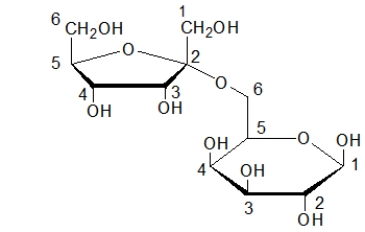
A) β-(2→4)
B) α-(1→4)
C) β-(1→4)
D) α-(2→4)
E) α-(2→6)

A) β-(2→4)
B) α-(1→4)
C) β-(1→4)
D) α-(2→4)
E) α-(2→6)

Unlock Deck
Unlock for access to all 97 flashcards in this deck.
Unlock Deck
k this deck
5
Below is the open-chain form of fructose, followed by several cyclic monosaccharides.Choose the cyclic monosaccharides that are the ring form of fructose. 
A) Only structure II is D-fructose.
B) Only structure III is D-fructose.
C) Both structures I and II are D-fructose.
D) Both structure III and IV are D-fructose.
E) All of these structures are D-fructose.

A) Only structure II is D-fructose.
B) Only structure III is D-fructose.
C) Both structures I and II are D-fructose.
D) Both structure III and IV are D-fructose.
E) All of these structures are D-fructose.

Unlock Deck
Unlock for access to all 97 flashcards in this deck.
Unlock Deck
k this deck
6
Photosynthesis and cellular respiration together form___________.
A) metabolism
B) catabolism and anabolism
C) energy and matter
D) a biochemical pathway
E) the carbon cycle
A) metabolism
B) catabolism and anabolism
C) energy and matter
D) a biochemical pathway
E) the carbon cycle

Unlock Deck
Unlock for access to all 97 flashcards in this deck.
Unlock Deck
k this deck
7
Which of the following features is NOT shared by all monosaccharides?
A) Monosaccharides cannot be hydrolyzed into simpler carbohydrates.
B) Monosaccharides all contain six carbons.
C) Monosaccharides have an aldehyde or a ketone.
D) Monosaccharides contain two or more alcohols.
E) Monosaccharides are polyhydroxylated.
A) Monosaccharides cannot be hydrolyzed into simpler carbohydrates.
B) Monosaccharides all contain six carbons.
C) Monosaccharides have an aldehyde or a ketone.
D) Monosaccharides contain two or more alcohols.
E) Monosaccharides are polyhydroxylated.

Unlock Deck
Unlock for access to all 97 flashcards in this deck.
Unlock Deck
k this deck
8
Type _____ blood is the universal donor, whereas type _____ is the universal recipient.
A) O; AB
B) AB; O
C) A; B
D) B; A
E) O; A or B
A) O; AB
B) AB; O
C) A; B
D) B; A
E) O; A or B

Unlock Deck
Unlock for access to all 97 flashcards in this deck.
Unlock Deck
k this deck
9
Which of the following statements related to the formation of dental caries is FALSE?
A) Anaerobic bacteria produce lactic acid.
B) Anaerobic bacteria convert glucose into carbon dioxide and water.
C) Lactic acid reduces the pH of the environment of the tooth enamel to pH 4-5.
D) Tooth enamel dissolves in a pH 4-5 environment.
E) Brushing removes sugars from the teeth.
A) Anaerobic bacteria produce lactic acid.
B) Anaerobic bacteria convert glucose into carbon dioxide and water.
C) Lactic acid reduces the pH of the environment of the tooth enamel to pH 4-5.
D) Tooth enamel dissolves in a pH 4-5 environment.
E) Brushing removes sugars from the teeth.

Unlock Deck
Unlock for access to all 97 flashcards in this deck.
Unlock Deck
k this deck
10
The Fischer projection for fructose is shown below.Which functional group(s)does fructose contain? 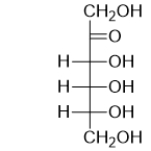
A) an aldehyde only
B) hydroxyl groups only
C) hydroxyl groups and an alkene
D) hydroxyl groups and a ketone
E) hydroxyl groups and an aldehyde

A) an aldehyde only
B) hydroxyl groups only
C) hydroxyl groups and an alkene
D) hydroxyl groups and a ketone
E) hydroxyl groups and an aldehyde

Unlock Deck
Unlock for access to all 97 flashcards in this deck.
Unlock Deck
k this deck
11
Which of the following types of carbohydrates can be hydrolyzed to give smaller molecules? I.Monosaccharides
II)Disaccharides
III)Oligosaccharides
IV)Polysaccharides
A) I only
B) II and IV only
C) III only
D) I and II only
E) II, III, and IV
II)Disaccharides
III)Oligosaccharides
IV)Polysaccharides
A) I only
B) II and IV only
C) III only
D) I and II only
E) II, III, and IV

Unlock Deck
Unlock for access to all 97 flashcards in this deck.
Unlock Deck
k this deck
12
Do you expect monosaccharides to be soluble in water?
A) Yes, because monosaccharides are acidic.
B) No, because monosaccharides have too many carbons to be soluble.
C) Yes, because monosaccharides can hydrogen bond with water.
D) No, because monosaccharides cannot form intermolecular attractive forces with water.
E) Yes, because monosaccharides are basic.
A) Yes, because monosaccharides are acidic.
B) No, because monosaccharides have too many carbons to be soluble.
C) Yes, because monosaccharides can hydrogen bond with water.
D) No, because monosaccharides cannot form intermolecular attractive forces with water.
E) Yes, because monosaccharides are basic.

Unlock Deck
Unlock for access to all 97 flashcards in this deck.
Unlock Deck
k this deck
13
Sucrose, the disaccharide shown below, is a nonreducing sugar because 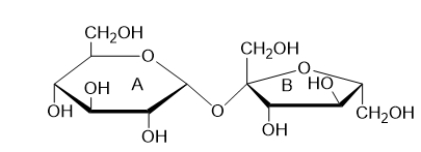
A) it is a disaccharide.
B) ring A can open and form a carbonyl.
C) ring B can open and form a carbonyl.
D) it contains a glycosidic linkage.
E) neither ring can open.

A) it is a disaccharide.
B) ring A can open and form a carbonyl.
C) ring B can open and form a carbonyl.
D) it contains a glycosidic linkage.
E) neither ring can open.

Unlock Deck
Unlock for access to all 97 flashcards in this deck.
Unlock Deck
k this deck
14
Which object is chiral?
A) a screw
B) a nail
C) a pencil
D) a table
E) a bed
A) a screw
B) a nail
C) a pencil
D) a table
E) a bed

Unlock Deck
Unlock for access to all 97 flashcards in this deck.
Unlock Deck
k this deck
15
A racemic mixture is
A) a 50:50 mixture of enantiomers.
B) optically active.
C) a pure sample of a single enantiomer.
D) dextrorotatory.
E) indicated by the IUPAC prefix R.
A) a 50:50 mixture of enantiomers.
B) optically active.
C) a pure sample of a single enantiomer.
D) dextrorotatory.
E) indicated by the IUPAC prefix R.

Unlock Deck
Unlock for access to all 97 flashcards in this deck.
Unlock Deck
k this deck
16
In which of the following Haworth projections is the arrow pointing to the anomeric carbon? 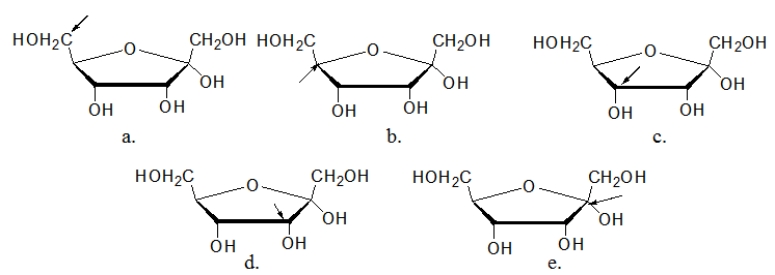
A) structure a
B) structure b
C) structure c
D) structure d
E) structure e

A) structure a
B) structure b
C) structure c
D) structure d
E) structure e

Unlock Deck
Unlock for access to all 97 flashcards in this deck.
Unlock Deck
k this deck
17
What is the relationship between D- and L-glucose?
A) They are identical.
B) They are constitutional isomers.
C) They are diastereomers.
D) They are enantiomers.
E) They are conformers.
A) They are identical.
B) They are constitutional isomers.
C) They are diastereomers.
D) They are enantiomers.
E) They are conformers.

Unlock Deck
Unlock for access to all 97 flashcards in this deck.
Unlock Deck
k this deck
18
What is the product(s)of the hydrolysis of the following sugar? 
A)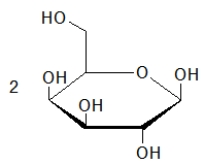
B)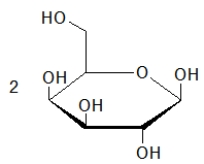
C)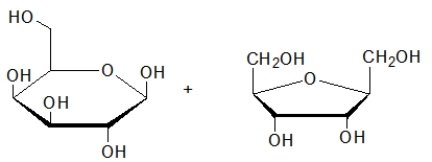
D)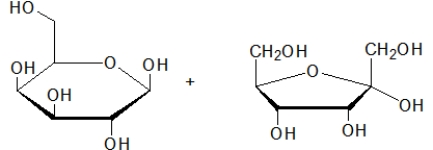
E)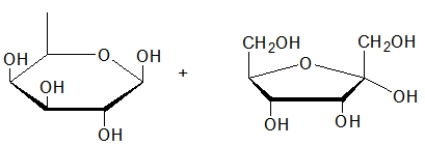

A)

B)

C)

D)

E)


Unlock Deck
Unlock for access to all 97 flashcards in this deck.
Unlock Deck
k this deck
19
Which disaccharide is found in milk?
A) lactose
B) sucrose
C) cellobiose
D) maltose
E) both cellobiose and maltose
A) lactose
B) sucrose
C) cellobiose
D) maltose
E) both cellobiose and maltose

Unlock Deck
Unlock for access to all 97 flashcards in this deck.
Unlock Deck
k this deck
20
Nature produces predominantly __________-carbohydrates and _______-amino acids.
A) D, D
B) D, L
C) L, D
D) L, L
E) Nature does not favor one stereoisomer over another.
A) D, D
B) D, L
C) L, D
D) L, L
E) Nature does not favor one stereoisomer over another.

Unlock Deck
Unlock for access to all 97 flashcards in this deck.
Unlock Deck
k this deck
21
What is the relationship between the two molecules shown? 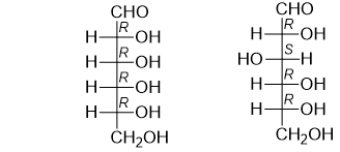
A) identical molecules
B) isomers
C) enantiomers
D) conformations
E) diastereomers

A) identical molecules
B) isomers
C) enantiomers
D) conformations
E) diastereomers

Unlock Deck
Unlock for access to all 97 flashcards in this deck.
Unlock Deck
k this deck
22
The open-chain form of a carbohydrate contains a carbonyl group.This carbonyl group reacts to become an alcohol when the ring closes, forming the anomeric carbon.The type of carbonyl determines which type of ring is formed.Select the choice in which the type of carbonyl is paired with the correct type of ring that is formed.
A) ketone and pyranose
B) aldehyde and pyranose
C) carboxylic acid and furanose
D) carboxylic acid and pyranose
E) aldehyde and furanose
A) ketone and pyranose
B) aldehyde and pyranose
C) carboxylic acid and furanose
D) carboxylic acid and pyranose
E) aldehyde and furanose

Unlock Deck
Unlock for access to all 97 flashcards in this deck.
Unlock Deck
k this deck
23
Animals cannot digest________, but ruminants such as horses and cows have bacteria in their digestive track that can digest it.
A) amylose
B) amylopectin
C) glycogen
D) cellulose
E) amylose and amylopectin
A) amylose
B) amylopectin
C) glycogen
D) cellulose
E) amylose and amylopectin

Unlock Deck
Unlock for access to all 97 flashcards in this deck.
Unlock Deck
k this deck
24
Select the species present in higher concentration at equilibrium in aqueous solution. 
A) I
B) II
C) III
D) II and III
E) There are equal concentrations of these three species in solution.

A) I
B) II
C) III
D) II and III
E) There are equal concentrations of these three species in solution.

Unlock Deck
Unlock for access to all 97 flashcards in this deck.
Unlock Deck
k this deck
25
How are disaccharides separated into two monosaccharides?
A) It is not possible to separate disaccharides into monosaccharides.
B) by esterification
C) by hydration
D) by hydrolysis
E) by amidation
A) It is not possible to separate disaccharides into monosaccharides.
B) by esterification
C) by hydration
D) by hydrolysis
E) by amidation

Unlock Deck
Unlock for access to all 97 flashcards in this deck.
Unlock Deck
k this deck
26
What do the IUPAC prefixes R and S indicate about a molecule?
A) the relative size of the molecule
B) the solubility of the molecule
C) whether the molecule is a sugar or not
D) the configuration of chirality center
E) the reactivity of the molecule
A) the relative size of the molecule
B) the solubility of the molecule
C) whether the molecule is a sugar or not
D) the configuration of chirality center
E) the reactivity of the molecule

Unlock Deck
Unlock for access to all 97 flashcards in this deck.
Unlock Deck
k this deck
27
Which one of these molecules is a naturally occurring sugar?
A)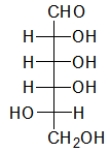
B)
C)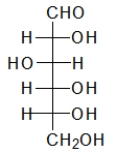
D)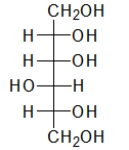
E)
A)

B)

C)

D)

E)


Unlock Deck
Unlock for access to all 97 flashcards in this deck.
Unlock Deck
k this deck
28
A patient with chronic pancreatitis has her pancreas removed.Which of the following effects would be most likely?
A) nothing
B) the regeneration of the pancreas
C) type I diabetes
D) type II diabetes
E) hypoglycemia
A) nothing
B) the regeneration of the pancreas
C) type I diabetes
D) type II diabetes
E) hypoglycemia

Unlock Deck
Unlock for access to all 97 flashcards in this deck.
Unlock Deck
k this deck
29
In which of the following Haworth projections is the arrow pointing to the anomeric carbon? 
A) structure a
B) structure b
C) structure c
D) structure d
E) structure e

A) structure a
B) structure b
C) structure c
D) structure d
E) structure e

Unlock Deck
Unlock for access to all 97 flashcards in this deck.
Unlock Deck
k this deck
30
How are glycosidic linkages broken during catabolism of sugars?
A) by oxidation
B) by reduction
C) by hydrolysis
D) by hydrogenation
E) by dehydration
A) by oxidation
B) by reduction
C) by hydrolysis
D) by hydrogenation
E) by dehydration

Unlock Deck
Unlock for access to all 97 flashcards in this deck.
Unlock Deck
k this deck
31
The structures of mannose and galactose are given below.What is the relationship between these two monosaccharides? 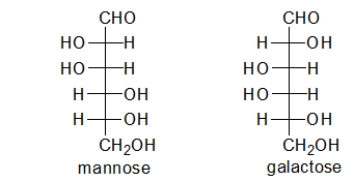
A) They are identical.
B) They are constitutional isomers.
C) They are diastereomers.
D) They are enantiomers.
E) They are conformers.

A) They are identical.
B) They are constitutional isomers.
C) They are diastereomers.
D) They are enantiomers.
E) They are conformers.

Unlock Deck
Unlock for access to all 97 flashcards in this deck.
Unlock Deck
k this deck
32
The most common polysaccharides found in plants and animals are polymers of
A) galactose.
B) glucose.
C) fructose.
D) glucose and fructose.
E) glucose, fructose, and galactose.
A) galactose.
B) glucose.
C) fructose.
D) glucose and fructose.
E) glucose, fructose, and galactose.

Unlock Deck
Unlock for access to all 97 flashcards in this deck.
Unlock Deck
k this deck
33
The following molecule is a __________. 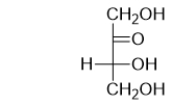
A) ketotriose
B) ketohexose
C) aldopentose
D) ketotetrose
E) aldohexose

A) ketotriose
B) ketohexose
C) aldopentose
D) ketotetrose
E) aldohexose

Unlock Deck
Unlock for access to all 97 flashcards in this deck.
Unlock Deck
k this deck
34
Which of the following classes of biomolecules causes dental caries?
A) carbohydrates
B) proteins
C) fats
D) nucleic acids
E) All foods cause dental caries.
A) carbohydrates
B) proteins
C) fats
D) nucleic acids
E) All foods cause dental caries.

Unlock Deck
Unlock for access to all 97 flashcards in this deck.
Unlock Deck
k this deck
35
Which of the following sugars is called "blood sugar"?
A) glucose
B) glycogen
C) fructose
D) sucrose
E) All of the above are called blood sugar.
A) glucose
B) glycogen
C) fructose
D) sucrose
E) All of the above are called blood sugar.

Unlock Deck
Unlock for access to all 97 flashcards in this deck.
Unlock Deck
k this deck
36
Which statement BEST describes mutarotation?
A) The open chain, α-anomer and β-anomer of a sugar are in equilibrium in solution.
B) The sugar spins around (rotates)in solution.
C) The sugar mutates in solution.
D) The sugar decomposes in solution.
E) The sugar both spins around and mutates in solution.
A) The open chain, α-anomer and β-anomer of a sugar are in equilibrium in solution.
B) The sugar spins around (rotates)in solution.
C) The sugar mutates in solution.
D) The sugar decomposes in solution.
E) The sugar both spins around and mutates in solution.

Unlock Deck
Unlock for access to all 97 flashcards in this deck.
Unlock Deck
k this deck
37
Which statement BEST describes photosynthesis?
A) the breakdown of starch into CO2, H2O, and energy
B) the breakdown of starch into CO2 and H2O using energy
C) the synthesis of starch from CO2, H2O, and energy
D) the synthesis of starch and energy from CO2 and H2O
E) Photosynthesis applies to all of the above processes.
A) the breakdown of starch into CO2, H2O, and energy
B) the breakdown of starch into CO2 and H2O using energy
C) the synthesis of starch from CO2, H2O, and energy
D) the synthesis of starch and energy from CO2 and H2O
E) Photosynthesis applies to all of the above processes.

Unlock Deck
Unlock for access to all 97 flashcards in this deck.
Unlock Deck
k this deck
38
The Fischer projection for fructose is shown below.Which carbon determines whether the sugar is D- or L-? 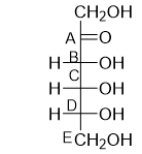
A) carbon A
B) carbon B
C) carbon C
D) carbon D
E) carbon E

A) carbon A
B) carbon B
C) carbon C
D) carbon D
E) carbon E

Unlock Deck
Unlock for access to all 97 flashcards in this deck.
Unlock Deck
k this deck
39
A patient undergoing a kidney transplant is given a kidney from a person with type B blood when the patient is, in fact, type O.What effect of this mistake would be most likely?
A) Nothing, blood type does not matter in organ transplants.
B) Nothing, type O is the universal recipient.
C) organ failure
D) coma
E) a mild allergic reaction
A) Nothing, blood type does not matter in organ transplants.
B) Nothing, type O is the universal recipient.
C) organ failure
D) coma
E) a mild allergic reaction

Unlock Deck
Unlock for access to all 97 flashcards in this deck.
Unlock Deck
k this deck
40
In which of the sugars below is the arrow pointing to the carbon that determines whether a sugar is α- or β-? 
A) structure a
B) structure b
C) structure c
D) structure d
E) structure e

A) structure a
B) structure b
C) structure c
D) structure d
E) structure e

Unlock Deck
Unlock for access to all 97 flashcards in this deck.
Unlock Deck
k this deck
41
Why can't insulin be taken orally?
A) It does not taste very good.
B) Enzymes in the saliva break it down.
C) Hydrolysis of insulin occurs in the stomach.
D) It is not possible to store insulin.
E) All of the above
A) It does not taste very good.
B) Enzymes in the saliva break it down.
C) Hydrolysis of insulin occurs in the stomach.
D) It is not possible to store insulin.
E) All of the above

Unlock Deck
Unlock for access to all 97 flashcards in this deck.
Unlock Deck
k this deck
42
Molecules that have a different configuration at one or more chirality centers, but not all chirality centers, are called __________.
A) identical molecules
B) isomers
C) enantiomers
D) conformations
E) diastereomers
A) identical molecules
B) isomers
C) enantiomers
D) conformations
E) diastereomers

Unlock Deck
Unlock for access to all 97 flashcards in this deck.
Unlock Deck
k this deck
43
Which of the following blood types can be donated to someone with type A blood?
A) type A only
B) type A or type O
C) type A or type AB
D) any of the blood types except A
E) Type A can receive blood from any of the blood types.
A) type A only
B) type A or type O
C) type A or type AB
D) any of the blood types except A
E) Type A can receive blood from any of the blood types.

Unlock Deck
Unlock for access to all 97 flashcards in this deck.
Unlock Deck
k this deck
44
The figure below illustrates a(n) 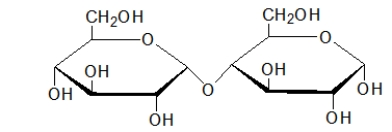
A) monosaccharide.
B) simple sugar.
C) disaccharide.
D) polysaccharide.
E) oligosaccharide.

A) monosaccharide.
B) simple sugar.
C) disaccharide.
D) polysaccharide.
E) oligosaccharide.

Unlock Deck
Unlock for access to all 97 flashcards in this deck.
Unlock Deck
k this deck
45
Starches in our diet can contain up to __________of glucose units.
A) tens
B) hundreds
C) thousands
D) millions
E) billions
A) tens
B) hundreds
C) thousands
D) millions
E) billions

Unlock Deck
Unlock for access to all 97 flashcards in this deck.
Unlock Deck
k this deck
46
Which of the following sugars is the enantiomer of D-glucose? 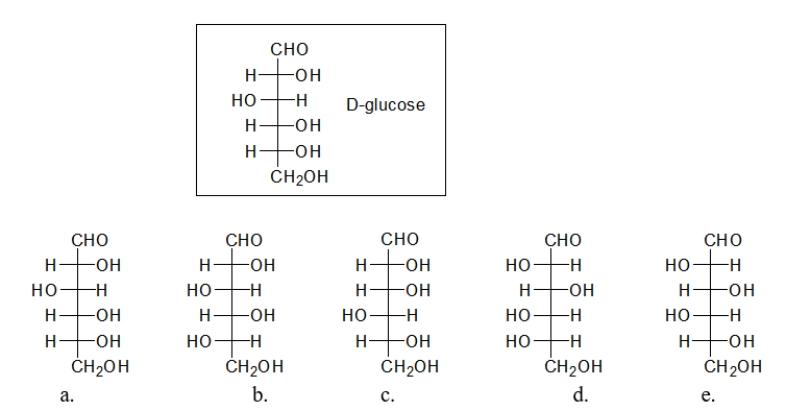
A) sugar a
B) sugar b
C) sugar c
D) sugar d
E) sugar e

A) sugar a
B) sugar b
C) sugar c
D) sugar d
E) sugar e

Unlock Deck
Unlock for access to all 97 flashcards in this deck.
Unlock Deck
k this deck
47
Which of the following blood types is MOST common?
A) A
B) B
C) AB
D) O
E) They are equally common.
A) A
B) B
C) AB
D) O
E) They are equally common.

Unlock Deck
Unlock for access to all 97 flashcards in this deck.
Unlock Deck
k this deck
48
Plants store energy in the form of
A) amylose.
B) amylopectin.
C) glycogen.
D) cellulose.
E) amylose and amylopectin.
A) amylose.
B) amylopectin.
C) glycogen.
D) cellulose.
E) amylose and amylopectin.

Unlock Deck
Unlock for access to all 97 flashcards in this deck.
Unlock Deck
k this deck
49
Which arrow is pointing to a glycosidic bond? 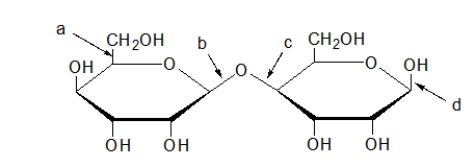
A) a only
B) b only
C) c only
D) b and c
E) b, c, and d

A) a only
B) b only
C) c only
D) b and c
E) b, c, and d

Unlock Deck
Unlock for access to all 97 flashcards in this deck.
Unlock Deck
k this deck
50
What is the relationship between the two molecules shown? 
A) identical molecules
B) isomers
C) enantiomers
D) conformations
E) diastereomers

A) identical molecules
B) isomers
C) enantiomers
D) conformations
E) diastereomers

Unlock Deck
Unlock for access to all 97 flashcards in this deck.
Unlock Deck
k this deck
51
What polysaccharides are made of glucose?
A) amylose
B) amylopectin
C) glycogen
D) cellulose
E) All of the above are made of glucose.
A) amylose
B) amylopectin
C) glycogen
D) cellulose
E) All of the above are made of glucose.

Unlock Deck
Unlock for access to all 97 flashcards in this deck.
Unlock Deck
k this deck
52
Which statement BEST describes how a cell distinguishes between a host cell and foreign cell?
A) Antibodies detect foreign cells.
B) This is what T-cells do.
C) Oligosaccharide cell markers on the surface of the cell do this.
D) A cell sends out special proteins to do this.
E) The proteins within the cell membrane do this.
A) Antibodies detect foreign cells.
B) This is what T-cells do.
C) Oligosaccharide cell markers on the surface of the cell do this.
D) A cell sends out special proteins to do this.
E) The proteins within the cell membrane do this.

Unlock Deck
Unlock for access to all 97 flashcards in this deck.
Unlock Deck
k this deck
53
Which glycosidic linkage does the sugar shown below contain? 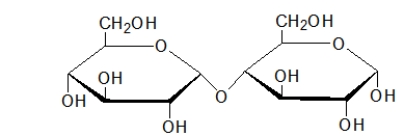
A) β-(2→4)
B) α-(1→4)
C) β-(1→4)
D) α-(2→4)
E) α-(2→6)

A) β-(2→4)
B) α-(1→4)
C) β-(1→4)
D) α-(2→4)
E) α-(2→6)

Unlock Deck
Unlock for access to all 97 flashcards in this deck.
Unlock Deck
k this deck
54
What is the relationship between the following two molecules? 
A) They are enantiomers.
B) They are identical.
C) They are conformers.
D) They are constitutional isomers.
E) They are unrelated.

A) They are enantiomers.
B) They are identical.
C) They are conformers.
D) They are constitutional isomers.
E) They are unrelated.

Unlock Deck
Unlock for access to all 97 flashcards in this deck.
Unlock Deck
k this deck
55
Which of the following is NOT a function of carbohydrates?
A) Carbohydrates are used for long-term energy storage.
B) Carbohydrates are fuels for cells.
C) Carbohydrates are part of DNA and RNA.
D) Carbohydrates are used in cellular recognition.
E) Carbohydrates make some foods taste sweet.
A) Carbohydrates are used for long-term energy storage.
B) Carbohydrates are fuels for cells.
C) Carbohydrates are part of DNA and RNA.
D) Carbohydrates are used in cellular recognition.
E) Carbohydrates make some foods taste sweet.

Unlock Deck
Unlock for access to all 97 flashcards in this deck.
Unlock Deck
k this deck
56
Which statement about enantiomers is TRUE?
A) Enantiomers have different boiling points and melting points.
B) Enantiomers are easy to separate in the laboratory.
C) Enantiomers bind to receptors equally effectively.
D) Only one enantiomer of a drug will have a pharmacological effect.
E) Enantiomers may have different properties in a chiral environment.
A) Enantiomers have different boiling points and melting points.
B) Enantiomers are easy to separate in the laboratory.
C) Enantiomers bind to receptors equally effectively.
D) Only one enantiomer of a drug will have a pharmacological effect.
E) Enantiomers may have different properties in a chiral environment.

Unlock Deck
Unlock for access to all 97 flashcards in this deck.
Unlock Deck
k this deck
57
Which arrow is pointing to a glycosidic bond? 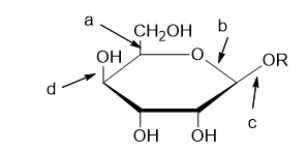
A) a only
B) b only
C) c only
D) b and c
E) b, c, and d

A) a only
B) b only
C) c only
D) b and c
E) b, c, and d

Unlock Deck
Unlock for access to all 97 flashcards in this deck.
Unlock Deck
k this deck
58
Which statement does NOT describe the anomeric carbon?
A) It is the carbon of the carbonyl in the open-chain form of the sugar.
B) This carbon is attached to two oxygens in the ring form of the compound.
C) The hydroxyl group on this carbon can be above or below the ring.
D) Glucose does not contain an anomeric carbon.
E) The anomeric carbon is a chirality center.
A) It is the carbon of the carbonyl in the open-chain form of the sugar.
B) This carbon is attached to two oxygens in the ring form of the compound.
C) The hydroxyl group on this carbon can be above or below the ring.
D) Glucose does not contain an anomeric carbon.
E) The anomeric carbon is a chirality center.

Unlock Deck
Unlock for access to all 97 flashcards in this deck.
Unlock Deck
k this deck
59
Which statement about chiral molecules is FALSE?
A) Monosaccharides D-glyceraldehyde and L-glyceraldehyde are enantiomers.
B) Chiral molecules are nonsuperimposable on their mirror image.
C) D-glyceraldehyde and L-glyceraldehyde can be synthesized in the laboratory.
D) Chiral molecules are extremely rare in the body.
E) D-glyceraldehyde, but not L-glyceraldehyde, is produced by our cells.
A) Monosaccharides D-glyceraldehyde and L-glyceraldehyde are enantiomers.
B) Chiral molecules are nonsuperimposable on their mirror image.
C) D-glyceraldehyde and L-glyceraldehyde can be synthesized in the laboratory.
D) Chiral molecules are extremely rare in the body.
E) D-glyceraldehyde, but not L-glyceraldehyde, is produced by our cells.

Unlock Deck
Unlock for access to all 97 flashcards in this deck.
Unlock Deck
k this deck
60
The most common disease in the world is
A) heart disease.
B) cancer.
C) tooth decay.
D) amoebic dysentery.
E) malaria.
A) heart disease.
B) cancer.
C) tooth decay.
D) amoebic dysentery.
E) malaria.

Unlock Deck
Unlock for access to all 97 flashcards in this deck.
Unlock Deck
k this deck
61
How many stereogenic centers does the following molecule have? 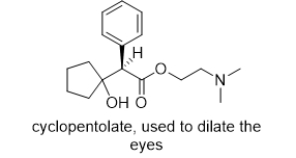
A) 0
B) 1
C) 2
D) 3
E) 4

A) 0
B) 1
C) 2
D) 3
E) 4

Unlock Deck
Unlock for access to all 97 flashcards in this deck.
Unlock Deck
k this deck
62
The Fischer projection for fructose is shown below.Is it a D-sugar or an L-sugar? 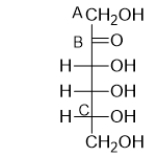
A) It is a D-sugar because the hydroxyl at carbon A is to the right.
B) It is a D-sugar because the carbonyl at carbon B is to the right.
C) It is a D-sugar because the hydroxyl at carbon C is to the right.
D) It is an L-sugar because the carbonyl at carbon B is to the right.
E) It is an L-sugar because the hydroxyl at carbon C is to the right.

A) It is a D-sugar because the hydroxyl at carbon A is to the right.
B) It is a D-sugar because the carbonyl at carbon B is to the right.
C) It is a D-sugar because the hydroxyl at carbon C is to the right.
D) It is an L-sugar because the carbonyl at carbon B is to the right.
E) It is an L-sugar because the hydroxyl at carbon C is to the right.

Unlock Deck
Unlock for access to all 97 flashcards in this deck.
Unlock Deck
k this deck
63
Which carbon(s)in the Fischer projection below is/are tetrahedral? 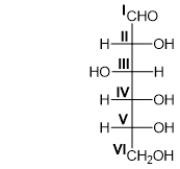
A) all carbons
B) carbon I only
C) carbon I and VI only
D) carbons II, III, IV, and V
E) carbons II through VI

A) all carbons
B) carbon I only
C) carbon I and VI only
D) carbons II, III, IV, and V
E) carbons II through VI

Unlock Deck
Unlock for access to all 97 flashcards in this deck.
Unlock Deck
k this deck
64
Which structures is an α-anomer? 
A) structure a
B) structure b
C) structure c
D) structure d
E) structure e

A) structure a
B) structure b
C) structure c
D) structure d
E) structure e

Unlock Deck
Unlock for access to all 97 flashcards in this deck.
Unlock Deck
k this deck
65
Cellulose and starch are similar in that they are both polymers of glucose.Cellulose, however, forms sheet-like structures, which give rigidity to a plant, whereas starch forms spirals.What accounts for this difference in macroscopic structure?
A) Cellulose is composed of D-glucose, whereas starch is composed of L-glucose.
B) Cellulose and starch are connected together on different carbons.
C) Cellulose is composed of L-glucose, whereas starch is composed of D-glucose.
D) Cellulose has a β-(1→4)linkage, whereas starch has an α-(1→4)linkage.
E) Starch has a β-(1→4)linkage, whereas cellulose has an α-(1→4)linkage.
A) Cellulose is composed of D-glucose, whereas starch is composed of L-glucose.
B) Cellulose and starch are connected together on different carbons.
C) Cellulose is composed of L-glucose, whereas starch is composed of D-glucose.
D) Cellulose has a β-(1→4)linkage, whereas starch has an α-(1→4)linkage.
E) Starch has a β-(1→4)linkage, whereas cellulose has an α-(1→4)linkage.

Unlock Deck
Unlock for access to all 97 flashcards in this deck.
Unlock Deck
k this deck
66
A molecule that is chiral has no _________.
A) tetrahedral carbons
B) heteroatoms
C) mirror plane
D) reflection
E) conformations
A) tetrahedral carbons
B) heteroatoms
C) mirror plane
D) reflection
E) conformations

Unlock Deck
Unlock for access to all 97 flashcards in this deck.
Unlock Deck
k this deck
67
The Fischer projection for fructose is shown below.Fructose is a _________. 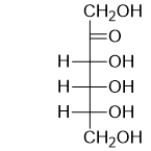
A) triose
B) tetrose
C) pentose
D) hexose
E) heptose

A) triose
B) tetrose
C) pentose
D) hexose
E) heptose

Unlock Deck
Unlock for access to all 97 flashcards in this deck.
Unlock Deck
k this deck
68
How can it be determined whether a sugar is α- or β- by looking at the Haworth projection?
A) α-anomer: The -OH on the anomeric carbon is above the ring.β-anomer: The -OH on the anomeric carbon is below the ring.
B) α-anomer: The -CH2OH of carbon 6 is above the ring.β-anomer: The -CH2OH of carbon 6 is below the ring.
C) α-anomer: The -OH on the anomeric carbon is below the ring.β-anomer: The -OH on the anomeric carbon is above the ring.
D) α-anomer: The -CH2OH of carbon 6 is below the ring.β-anomer: The -CH2OH of carbon 6 is above the ring.
E) Both b and d are true.
A) α-anomer: The -OH on the anomeric carbon is above the ring.β-anomer: The -OH on the anomeric carbon is below the ring.
B) α-anomer: The -CH2OH of carbon 6 is above the ring.β-anomer: The -CH2OH of carbon 6 is below the ring.
C) α-anomer: The -OH on the anomeric carbon is below the ring.β-anomer: The -OH on the anomeric carbon is above the ring.
D) α-anomer: The -CH2OH of carbon 6 is below the ring.β-anomer: The -CH2OH of carbon 6 is above the ring.
E) Both b and d are true.

Unlock Deck
Unlock for access to all 97 flashcards in this deck.
Unlock Deck
k this deck
69
The circled oxygen in the cyclic structure of glucose corresponds to which boxed oxygen in the linear structure? 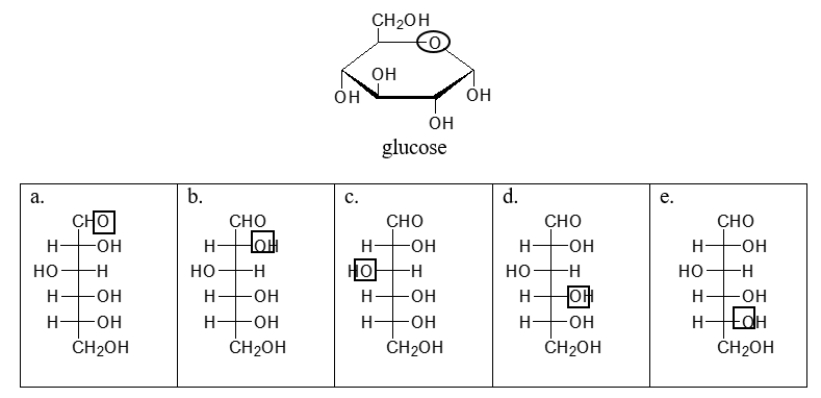
A) choice a
B) choice b
C) choice c
D) choice d
E) choice e

A) choice a
B) choice b
C) choice c
D) choice d
E) choice e

Unlock Deck
Unlock for access to all 97 flashcards in this deck.
Unlock Deck
k this deck
70
A molecule that is nonsuperimposable on its mirror image is/are ________.
A) impossible
B) chiral
C) reflective
D) identical
E) conformers
A) impossible
B) chiral
C) reflective
D) identical
E) conformers

Unlock Deck
Unlock for access to all 97 flashcards in this deck.
Unlock Deck
k this deck
71
Animals store energy in the form of
A) amylose.
B) amylopectin.
C) glycogen.
D) cellulose.
E) amylose and amylopectin.
A) amylose.
B) amylopectin.
C) glycogen.
D) cellulose.
E) amylose and amylopectin.

Unlock Deck
Unlock for access to all 97 flashcards in this deck.
Unlock Deck
k this deck
72
D-glucose is shown below.Which of the choices below is L-glucose? 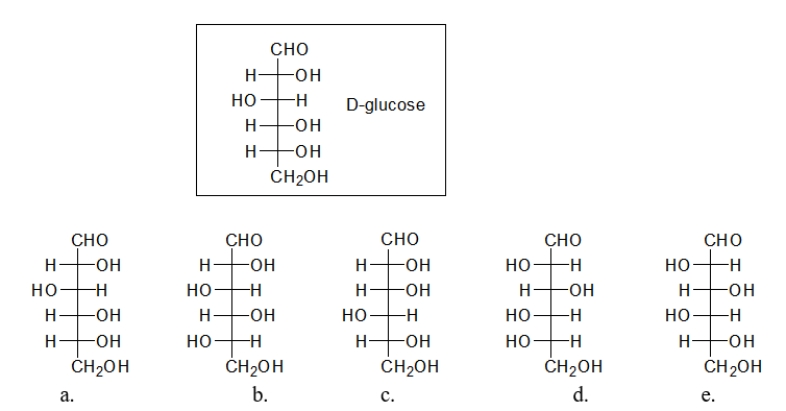
A) sugar a
B) sugar b
C) sugar c
D) sugar d
E) sugar e

A) sugar a
B) sugar b
C) sugar c
D) sugar d
E) sugar e

Unlock Deck
Unlock for access to all 97 flashcards in this deck.
Unlock Deck
k this deck
73
Which of the following is a monosaccharide?
A) cellulose
B) starch
C) glucose
D) sucrose
E) maltose
A) cellulose
B) starch
C) glucose
D) sucrose
E) maltose

Unlock Deck
Unlock for access to all 97 flashcards in this deck.
Unlock Deck
k this deck
74
A disaccharide has an α-(1→4)glycosidic linkage.Which statement about this sugar is TRUE?
A) Both monosaccharides in the disaccharide are linked at their anomeric carbon.
B) Both monosaccharides in the disaccharide are the α-anomer.
C) No part of the disaccharide can undergo mutarotation.
D) The closed ring form of the sugar linked at its carbon-4 is in equilibrium with its open-chain form.
E) It is a nonreducing sugar.
A) Both monosaccharides in the disaccharide are linked at their anomeric carbon.
B) Both monosaccharides in the disaccharide are the α-anomer.
C) No part of the disaccharide can undergo mutarotation.
D) The closed ring form of the sugar linked at its carbon-4 is in equilibrium with its open-chain form.
E) It is a nonreducing sugar.

Unlock Deck
Unlock for access to all 97 flashcards in this deck.
Unlock Deck
k this deck
75
Which carbon determines whether the sugar below is D- or L-? 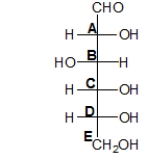
A) carbon A
B) carbon B
C) carbon C
D) carbon D
E) carbon E

A) carbon A
B) carbon B
C) carbon C
D) carbon D
E) carbon E

Unlock Deck
Unlock for access to all 97 flashcards in this deck.
Unlock Deck
k this deck
76
The circled carbon in the cyclic structure of glucose corresponds to which boxed carbon in the linear structure? 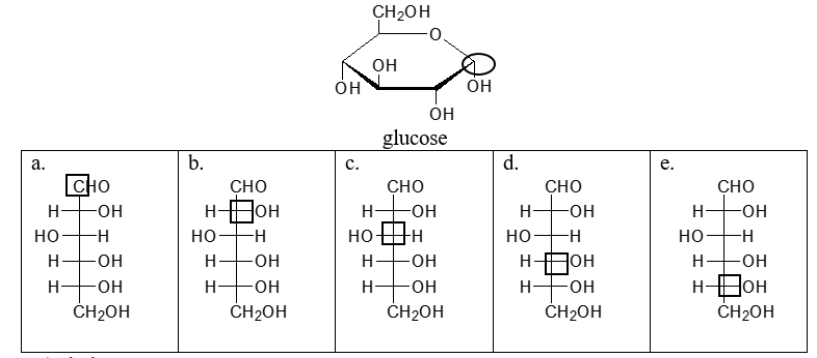
A) choice a
B) choice b
C) choice c
D) choice d
E) choice e

A) choice a
B) choice b
C) choice c
D) choice d
E) choice e

Unlock Deck
Unlock for access to all 97 flashcards in this deck.
Unlock Deck
k this deck
77
Which carbon of L-dopa is a chirality center? 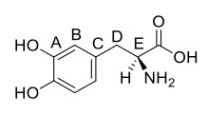
A) carbon A
B) carbon B
C) carbon C
D) carbon D
E) carbon E

A) carbon A
B) carbon B
C) carbon C
D) carbon D
E) carbon E

Unlock Deck
Unlock for access to all 97 flashcards in this deck.
Unlock Deck
k this deck
78
Which of the following molecules is NOT a polysaccharide?
A) amylose
B) amylopectin
C) cellulose
D) glycogen
E) glucose
A) amylose
B) amylopectin
C) cellulose
D) glycogen
E) glucose

Unlock Deck
Unlock for access to all 97 flashcards in this deck.
Unlock Deck
k this deck
79
Which of the following statements describes the role of insulin in the body? I.Insulin signals to cells to allow glucose to enter.
II)Insulin stimulates the conversion of glucose to glycogen.
III)Insulin stimulates the hydrolysis of glucose from glycogen.
A) All of these describe the role of insulin in the body.
B) I only
C) II only
D) III only
E) I and II
II)Insulin stimulates the conversion of glucose to glycogen.
III)Insulin stimulates the hydrolysis of glucose from glycogen.
A) All of these describe the role of insulin in the body.
B) I only
C) II only
D) III only
E) I and II

Unlock Deck
Unlock for access to all 97 flashcards in this deck.
Unlock Deck
k this deck
80
What is the relationship between the two molecules below? 
A) They are enantiomers.
B) They are identical.
C) They are conformers.
D) They are constitutional isomers.
E) They are unrelated.

A) They are enantiomers.
B) They are identical.
C) They are conformers.
D) They are constitutional isomers.
E) They are unrelated.

Unlock Deck
Unlock for access to all 97 flashcards in this deck.
Unlock Deck
k this deck



